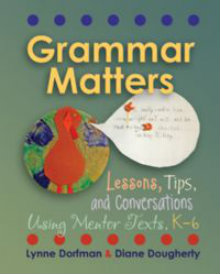Using Grammar to Build Better Writers
Grammar Matters: Lessons, Tips and Conversations Using Mentor Texts, K-6
By Lynne Dorfman and Diane Dougherty
(Stenhouse Publishers, 2014 – Learn more)
 Reviewed by Linda Biondi
Reviewed by Linda Biondi
Does grammar really matter? When I entered that question into Google search, I found that there were 23,700,000 results. Pretty amazing?
It’s hard to find someone who doesn’t have a pet peeve about language and grammar and how it should be taught. If you ask a sampling of teachers, you might hear…”It was good enough for me when I was growing up… I loved /hated diagramming sentences… Every student needs to have a grammar book and workbook… The computer is the reason why kids can’t write.”
 Or we might hear from the less-grammar-is-better group: “I loved writing because my teacher wrote along with us… I loved creative writing because I finally could express myself without getting bogged down in all those rules.”
Or we might hear from the less-grammar-is-better group: “I loved writing because my teacher wrote along with us… I loved creative writing because I finally could express myself without getting bogged down in all those rules.”
Sadly, I can remember the smell of the English textbooks and workbooks in elementary school and waiting with some trepidation for the year when we would finally move on to diagramming sentences. I can still diagram a sentence in record speed, but I don’t remember why it was so important.
Why grammar matters today
However you feel about the art or science of teaching grammar, it does matter. It matters in areas such as everyday writing, business communication, job applications, and responding to emails. (“Do U want 2 hire me?” doesn’t make it into the top three candidates to interview.) The National Council of Teachers of English (NCTE) states that “Grammar is important because it is the language that makes it possible for us to talk about language.” (Haussamen, et. al, 2014).
With the implementation of the Common Core State Standards there has been a renewed emphasis on grammar in the classroom. One strand of the English Language Arts Standards focuses on building “a foundation for college and career readiness in language,” and stresses that “students must gain control over many conventions of standard English grammar, usage, and mechanics.” Grammar is back.
Grammar immersion
Don’t despair, educators who fear the dull grammar instruction of yesteryear. There is hope. Lynne Dorfman and Diane Dougherty’s new book, Grammar Matters, is a hands-on guide to incorporating grammar into your writing program, whether it is Writers Workshop or something more traditional.
As educators we know that students achieve more in subjects with which they have higher engagement levels. Just like children are taught how to ride a bike by clambering onto the bike and getting a push, students need to experience grammar by being immersed in the doing of it.
Dorfman and Dougherty have published a book that will help you overcome the trials and tribulations of teaching grammar. It’s divided into four parts: Narrative Writing, Informational Writing, Opinion Writing, and Grammar Conversations, with practical and easily applicable lessons, teaching tips, grammar references, anchor charts, and mentor texts to use when you blend the strategies into Writers Workshop.
Visiting classrooms as coaching occurs
As I read the book, I felt as if a literacy coach was right next to me, answering questions as they came up and encouraging me to take a risk, try some of the ideas in the book, and refine teaching practices that I already use. Each chapter is devoted to a different genre and within the chapter you have a birds-eye view into classrooms as Dorfman and Dougherty collaborate with teachers.
A vivid explanation of each coaching session helps to recreate the experience in the reader’s mind. For example, in the chapter, “Using a Touchstone Text to Write Fiction,” we visited, through the text, fourth, fifth and sixth grade classrooms at Woodlynde School in Philadelphia as students worked to publish a piece of fiction that contained everyday characters, a setting, a problem and a solution.
A wide range of resources
Teachers always need to have a bag of tricks to keep students involved and actively participating in our lessons. This book comes with extra goodies embedded throughout, including: Grammar References (ways to address specific grammar concerns within the unit), Teaching Points (how to address problems that may occur during the lesson, and Student Samples from the coaching sessions.
The authors include examples of student writing – both drafts and published pieces – that I found especially helpful. I can read the Common Core Standards for each grade level and know what the expectations are. However, as a fourth grade teacher, I don’t have an opportunity to see actual mentor writing pieces at each grade level. These “real home” examples helped me gain a clearer understanding of what students are expected to be able to do.
The bonuses don’t seem to stop! I felt as if the authors were mind readers. Where can I find children’s books that embed grammar instruction? Look at their “Treasure Chest of Children’s Books.” What books are grade level appropriate to use for teaching the craft of grammar? Look at the section “Using Mentor Texts to Notice Grammatical Concepts and Punctuation,” a substantial list of fiction and nonfiction books to enhance grammar instruction.
There are also eight appendices with resources, such as examples of homophones, additional mentor texts, a glossary of grammar terms, an editing checklist, extra ideas for helping English Language Learners, and 10 top tips for the teachers of writers.
A book all of us can use
Grammar Matters is a book that every teacher can use, no matter what the discipline. The authors caution that the teaching of grammar should not be taught in isolation but embedded in your teaching throughout the year. Just as some math programs follow a spiral method, covering the same topics throughout the year or through the grade levels, advancing them by degrees on each pass, so should we teach grammar.
Be a “clipboard cruiser” (walking around the classroom to observe writing behaviors and areas of concern and strengths) as you examine and take notes on your students’ needs and growth. As a content area teacher, visit the book to see what you can use in your classroom. Does grammar matter? Absolutely.
Linda Biondi is a fourth grade teacher at Pond Road Middle School in Robbinsville, NJ, and a long-time Morning Meeting practitioner. She’s also the recipient of several educational grants, a Teacher Consultant with the National Writing Project and a participant on the NJ Department of Education Teacher Advisory Panel. She recently shared her thoughts about the Common Core at the NJ SDE website.


































